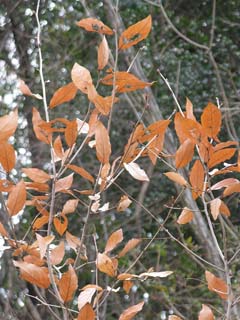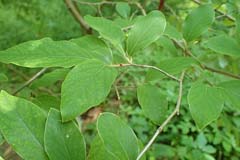 |
|
Wikimedia KENPEI |
 |
| Wikimedia Krzysztof Ziarnek, Kenraiz |
Translate this page:
Summary
Physical Characteristics

 Lindera glauca is a deciduous Shrub growing to 5 m (16ft) by 5 m (16ft).
Lindera glauca is a deciduous Shrub growing to 5 m (16ft) by 5 m (16ft).
See above for USDA hardiness. It is hardy to UK zone 6. The species is hermaphrodite (has both male and female organs).
Suitable for: light (sandy), medium (loamy) and heavy (clay) soils and prefers well-drained soil. Suitable pH: mildly acid, neutral and basic (mildly alkaline) soils. It can grow in semi-shade (light woodland) or no shade. It prefers moist soil.
UK Hardiness Map
US Hardiness Map
Synonyms
Benzoin glaucum Siebold & Zucc.
Plant Habitats
Woodland Garden Sunny Edge;
Edible Uses
The fruits are used as a substitute for pepper[301
].
The dried, powdered leaves are mixed into noodles and dumplings as a flavouring[301
].
References More on Edible Uses
Medicinal Uses
Plants For A Future can not take any responsibility for any adverse effects from the use of plants. Always seek advice from a professional before using a plant medicinally.
The roots, branchlets, leaves, and fruit are used medicinally[266].
References More on Medicinal Uses
The Bookshop: Edible Plant Books
Our Latest books on Perennial Plants For Food Forests and Permaculture Gardens in paperback or digital formats.

Edible Tropical Plants
Food Forest Plants for Hotter Conditions: 250+ Plants For Tropical Food Forests & Permaculture Gardens.
More

Edible Temperate Plants
Plants for Your Food Forest: 500 Plants for Temperate Food Forests & Permaculture Gardens.
More

More Books
PFAF have eight books available in paperback and digital formats. Browse the shop for more information.
Shop Now
Other Uses
An essential oil is obtained from the leaves and pericarp[266
]. It is used in the manufacture of incense and joss sticks[238
].
An oil obtained from the seed is used for making soap and lubricating oil[266
].
The wood is used in woodwork[266
]. Used in the manufacture of incense and joss sticks[238]. Attractive, aromatic foliage and star-shaped flowers and showy red to black fruit. Fragrant.
Special Uses
References More on Other Uses
Cultivation details
Light Range: Part Shade to Sun.
pH Range: 4.5 to 6.5.
Soil Range: Sandy Loam to Mostly Clay.
Water Range: Moist. Mixed deciduous forest. Shrub or small tree to 5 m, usually multistemmed. All these taxa are widely grown in North America and seem to perform well throughout the United States. Flowers Mid Spring. LINDERA glauca v. salicifolia (Chinese Spicebush)
has a pyramidal habit and willow-like foliage that emerges emerald-green in the spring turning yellow-orange and red then finally to khaki brown, holding on all winter. Jet black fruit appears in late summer. Use in a border, for screening or as a specimen.
References Carbon Farming Information and Carbon Sequestration Information
Temperature Converter
Type a value in the Celsius field to convert the value to Fahrenheit:
Fahrenheit:
The PFAF Bookshop
Plants For A Future have a number of books available in paperback and digital form. Book titles include Edible Plants, Edible Perennials, Edible Trees,Edible Shrubs, Woodland Gardening, and Temperate Food Forest Plants. Our new book is Food Forest Plants For Hotter Conditions (Tropical and Sub-Tropical).
Shop Now
Plant Propagation
Seed - best sown as soon as it is ripe. The seed has a short viability and should not be allowed to dry out[200
]. Prick out the seedlings into individual pots when they are large enough to handle and grow them on until large enough to plant out.
Cuttings of half-ripe wood in a frame[200
].
Layering.
Other Names
If available other names are mentioned here
Spicebush
Native Range
TEMPERATE ASIA: China (Anhui Sheng, Fujian Sheng, Gansu Sheng, Guangdong Sheng, Guangxi Zhuangzu Zizhiqu, Guizhou Sheng, Henan Sheng (southwest), Hubei Sheng, Hunan Sheng, Jiangxi Sheng, Shaanxi Sheng (southwest), Shandong Sheng (east), Shanxi Sheng, Sichuan Sheng, Zhejiang Sheng), Japan (Honshu (west), Kyushu, Shikoku), Taiwan
Weed Potential
Right plant wrong place. We are currently updating this section.
Please note that a plant may be invasive in one area but may not in your area so it's worth checking.
Conservation Status
IUCN Red List of Threatened Plants Status :

Growth: S = slow M = medium F = fast. Soil: L = light (sandy) M = medium H = heavy (clay). pH: A = acid N = neutral B = basic (alkaline). Shade: F = full shade S = semi-shade N = no shade. Moisture: D = dry M = Moist We = wet Wa = water.
Now available:
Food Forest Plants for Mediterranean Conditions
350+ Perennial Plants For Mediterranean and Drier Food Forests and Permaculture Gardens.
[Paperback and eBook]
This is the third in Plants For A Future's series of plant guides for food forests tailored to
specific climate zones. Following volumes on temperate and tropical ecosystems, this book focuses
on species suited to Mediterranean conditions—regions with hot, dry summers and cool, wet winters,
often facing the added challenge of climate change.
Read More
Expert comment
Author
(Siebold.&Zucc.)Blume.
Botanical References
Links / References
For a list of references used on this page please go here
Readers comment
| Add a comment |
|
If you have important information about this plant that may help other users please add a comment or link below. Only comments or links that are felt to be directly relevant to a plant will be included. If you think a comment/link or information contained on this page is inaccurate or misleading we would welcome your feedback at [email protected]. If you have questions about a plant please use the Forum on this website as we do not have the resources to answer questions ourselves.
* Please note: the comments by website users are not necessarily those held by PFAF and may give misleading or inaccurate information.
To leave a comment please Register or login here All comments need to be approved so will not appear immediately.
|
|